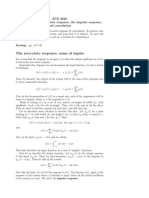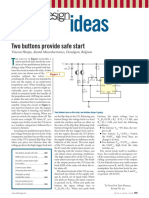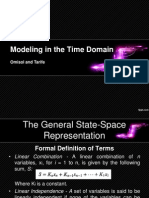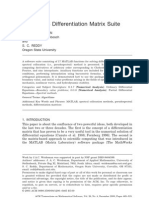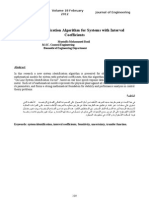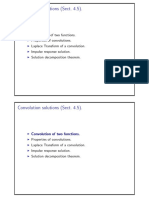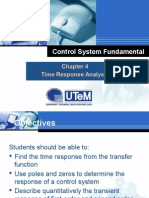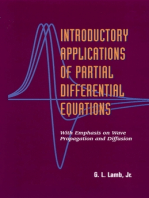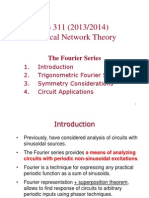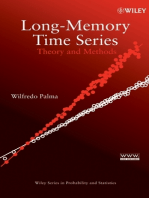Chapter 3 - Matlab
Uploaded by
Ze SaChapter 3 - Matlab
Uploaded by
Ze SaCHAPTER 3
THE DISCRETE-TIME FOURIER ANALYSIS
() h(n))
= () ()
DISCRETE-TIME FOURIER TRANSFORM (DTFT)
If x(n) is absolutely summable
() <
then
=
DTFT:
IDTFT (Inverse Discrete-Time Fourier Transform):
1
=
1
2
Example1: Determine the DTFT of = 0.5
()
Solution:
= =
=
= 0.5
0
= 0.5
=
1
1 0.5
0.5
0
Example2: Determine the DTFT of = 1,2,3,4,5
Solution:
= =
=
= 1
(1)
+ 0
0
+ (1)
1
+ x 2
2
+(3)
3
=
+ 2 +3
+4
2
+ 5
3
Properties of DTFT:
1. Periodicity
=
+2
2. Symmetry
Even symmetry:
odd symmetry:
even symmetry:
odd symmetry:
<
=<
Some Common DTFT Pairs:
Signal Type Sequence x(n)
DTFT
,
Unit Impulse () 1
Constant 1 2
Unit Step u(n)
1
1
+
Causal Exponential
()
1
1
Complex exponential
Cosine
+ +
Sine
Double exponential
() 1
2
1 2 +
2
The Properties of the DTFT:
1. Linearity
1
+
2
() =
1
+
2
3. Frequency Shifting
( ) =
4. Conjugation
() =
5. Folding
() =
2. Time Shifting
()
=
0
6. Symmetries in real sequences
=
()
if
then
() =
0
() =
7. Convolution
1
2
=
1
2
=
1
8. Multiplication
1
2
=
1
2
1
2
1
Periodic convolution
9. Energy
= ()
2
=
1
2
0
- PARSEVALS THEOREM
ENERGY DENSITY SPECTRUM
ENERGY OF x(n) in the band
1
,
2
The Frequency Domain Representation of LTI System
1. Response to a Complex Exponential
Let =
input to LTI system
h(n)
()
Then =
= ()
0
()
= ()
= ()
0
Frequency Response
- The discrete-time Fourier transform of an impulse response is called frequency
response (or transfer function) of an LTI system and is denoted by
()
H(
) =
h(n)
Magnitude or gain response function
<
Phase response function
2. Response to Sinusoidal Sequences
Let =
0
+
0
=
0
0
+
0
+ <
0
Steady state response,
H(
0
+
0
+ <
3. Response to Arbitrary Sequences
Let
= ()
and
= ()
Then using the convolution property
H(
=
1
=
1
2
Example: Determine the frequency response
of a system characterized by
= 0.9
(). Plot the magnitude and the phase responses.
Solution:
= ()
= 0.9
0
= 0.9
=
1
1 0.9
=
1
1 0.9
2
+ 0.9
2
=
1
1.81 1.8
<
=
0.9
1 0.9
Example : Causal Exponential Pulse
<
>
=
0 t 0
0 t
) (
bt
Ae
t v
From:
f j2 b
A
e A
) (
) ( ) (
0
)t j2 (b -
0
2
0
2
t
t
t
t
+
=
}
=
}
=
}
=
dt
dt e Ae f V
dt e t v f V
f
ft j bt
ft j
AN EXAMPLE ON HOW TO COMPUTE FOR AMPLITUDE
( )
A
f b
f j b
f j b
f j b
f j b
A
f V
2
2
2
2
2
2
2
) (
t
t
t
t
t
+
=
|
.
|
\
|
+
=
( ) | |
| |
2 2
2 2
) 2 (
2
) ( Im ) (
) 2 (
Re ) (
f b
fA
f V f V
f b
bA
f V f V
o
e
t
t
t
+
= =
+
= =
Convert to polar form to get and amplitude and phase spectrum:
( ) ( )
( ) ( )
( ) ( )
( )
( )
( )
( )
2
2
2
2
2
2
2
2
2
2 2
2
2
2
2 2
2
2 2
2
2 2
2 2
2
A
2
2
2
2
2
2 bA
) 2 (
2
) 2 (
) ( ) ( ) (
f b
f b
f b A
f b
f b A
f b
fA
f b
f
f b
bA
f V f V f V
c e
t
t
t
t
t
t
t
t
t
t
+
=
+
+
=
+
+
=
+
+
=
|
.
|
\
|
+
+ |
.
|
\
|
+
= + =
Amplitude Spectrum:
Phase Spectrum:
( )
( )
b
f 2
-arctan
bA
fA 2
- arctan
2
2
2
arctan
) (
) (
arctan ) ( arg
2
2
2
2
t
t
t
t
t
=
=
+
+
=
=
f b
bA
f b
fA
f V
f V
f V
e
o
4. Frequency Response Function from Difference Equations
+
( )
=0
+1
then
()
=
=1
()
=0
=0
1 +
=1
Example: An LTI system is specified by the difference equation
= 0.8 1 + ()
a. Determine
b. Calculate and plot the steady-state response
() to
Solution:
0.8 1 = ()
a.
=0
1 +
=1
=
1
1 0.8
= cos 0.05 ()
b. In the steady state the input is = cos 0.05 with frequency
0
= 0.05 and
0
= 0
0
therefore
= 4.0928 cos 0.05 0.5377 = 4.0928 0.05 3.42
0.05
=
1
1 0.8
0.05
= 4.0928
0.5377
Example: a 3
rd
-order LPF is described by the difference equation
= 0.081 +0.0543 1 +0.0543 2 + 0.0181 3 +
1.76 1 1.1829 2 + 0.2781 3
1.76 1 +1.1829 2 +0.2781 3 =
0.081 + 0.0543 1 +0.0543 2 +0.0181 3
Use matlab to plot
Introduction
2 mathematical tools in the analysis and
design of LTI systems:
Fourier Transform for nonperiodic signal
Fourier Series for periodic signal
Above signal representations decompose the
signals in terms of sinusoidal or complex
exponential components frequency domain
Frequency Analysis of Continuous-
Time Signals
Illustrated in prism by Isaac Newton
Joseph Fraunhofer observed that light consists
of distinct color lines
Gustav Kirchoff and Robert Bunsen found that
each chemical element, when heated to
incandescence, radiated its own distinct color
of light
Line spectrum identification of each chjemical
elements
Frequency analysis analysis of light into
colors
Spectrum frequency content of the signal
Spectrum estimation process of
determining the spectrum of a signal in
practice based on actual measurement of the
signal
Fourier Series for Continuous-Time
Periodic Signals
Developed by Jean Baptiste Joseph Fourier
period
1
T with
signal periodic ) ( if
0
p
2
0
l fundamenta
F
e c t x
k
t kF j
k
=
=
=
t
Frequency Analysis of Continuous Time Periodic Signals
Synthesis Equation
Analysis Equation
=
=
k
t kF j
k
e c t x
0
2
) (
t
}
=
p
T
t kF j
p
k
dt e t x
T
c
0
2
) (
1
t
If the periodic signal is real
k
k
j
k k
j
k k
e c c
then
e c c
u
u
=
=
and
( )
( ) ( ) | |
k k k
k k k
k
k k k
k
k k
c b
c a
c a
where
t kF b t kF a c c t x
t kF c c t x
u
u
t t
u t
sin 2
cos 2
2 sin 2 cos 2 ) (
real is when x(t) valued real is c where 2 cos 2 ) (
0 0
1
0 0 0
0
1
0 0
=
=
=
+ =
+ + =
=
Power Density Spectrum of Periodic
Signals
Periodic signals have:
Energy infinite
Average Power finite
signals power for relation ' ) (
1 2 2
s Parseval c dt t x
T
P
k
k
T
p
x
p
= =
}
=
Example: Find the power of the following signal
t kF j
k
e c t x
0
2
) (
t
=
Solution:
} }
=
= = =
k
k
T
k
p
T
p
x
c dt c
T
dt t x
T
P
p p
2 2 2 1
) (
1
Also called line spectrum because
the power of the periodic signal is
only at discrete values of frequencies
For real periodic signal, the total average power is
( )
=
=
+ + = + =
1
2 2 2
0
1
2
2
0
2
1
2
k
k k
k
k x
b a a c c P
k k k
k k k
c b
c a
c a
where
u
u
sin 2
cos 2
0 0
=
=
=
Example: Determine the Fourier series and the power density
spectrum of the rectangular pulse train signal as
illustrated below
2,... 1, k ,
sin A
2 F
A
2
1
) (
1
c
0 k
1
) (
1
c
x(t) signal the of component dc 0 k for
period T where
2
to
2
0
0
0
2 /
2 /
2 /
2 /
2
2
0
2
2
k
2 /
2 /
2 /
2 /
0
p
0 0
0
0
= =
=
(
=
=
=
=
= = =
=
}
}
} }
t t
t t t
t
t
t
t t t t
t
t
t
t
t
t
t
t
kF
kF
T
j
e e
kT
kF j
e
T
A
dt Ae
T
dt t x
T
for
T
A
Adt
T
dt t x
T
l fundamenta
T T
p
kF j kF j
p
T
T
kt F j
p
t kF j
p
p
T
T
p p p
p p
p
p
p
p
Solution:
since the signal is even, then integration interval is from
t t | |
t t
t t
0
0
0
kF where c sin
kF
kF sin
= =
| c sin =
varied with if t fixed T
p
t t >
p p
T T fixed when varied with if
Fourier Transform for Continuous-Time
Aperiodic Signals
If the periodic signal with
p
T
Then we can consider the signal as aperiodic/nonperiodic signal
}
}
=
=
s s =
=
= =
=
2 /
2 /
2
k
p p
p
2 /
2 /
2
k
o
2
p
0
0
) (
1
c
2
T
2
T -
for ) ( ) ( x sin
) (
1
c
1
F , ) ( x
) ( lim ) (
p
p
p
p
o
p
T
T
t kF j
p
T
T
t kF j
p
p
p
k
t kF j
k
p
T
dt e t x
T
then
t t x t ce
dt e t x
T
where
T
e c t from
t x t x
t
t
t
}
-
Ft j2 -
x(t)e X(F)
x(t) of Transform Fourier X(F)
dt
let
t
T
1
F
1
) ( x
) ( T
) (
1
c
) (
1
c from
p
2 2
p
0 p
0 k
2 /
2 /
2
k
0 0
0
= A
|
|
.
|
\
|
= =
|
|
.
|
\
|
= =
=
=
}
k
t kF j
p p
k
t kF j
k
p
k
p
T
T
t kF j
p
e
T
k
X
T
e c t from
T
k
X kF X c
or
kF X
T
dt e t x
T
p
p
t t
t
( )
( )
}
=
A
=
=
A A = =
A A
A A
=
-
2
2
T
p p
2
p
) ( ) x(t
lim ) ( ) ( lim
and
F F k and dF F ) ( ) ( x , T
) ( x
0
p
0
dF e F X
F e F k X t x t x so
t x t as
F e F k X
t
Ft j
k
t kF j
F
p
k
t kF j
t
t
t
FREQUENCY ANALYSIS OF CONTINUOUS TIME
APERIODIC SIGNALS
Synthesis Equation (inverse transform
Analysis equation (direct transform)
}
=
-
Ft j2 -
x(t)e X(F) dt
t
}
=
-
2
) ( x(t) dF e F X
Ft j t
IN RADIAN FORM
( )
( )
}
}
O
= O
O O =
dt e t x X
d e X t x
t j
t j
) (
2
1
) (
t
The Fourier Transform exists if it follows the Dirichlet Conditions:
1. The signal x(t) has a finite number of finite discontinuities.
2. The signal x(t) has a finite number of maxima and minima.
3. The signal x(t) is absolutely integrable, that is
}
< dt t x ) (
ENERGY DENSITY SPECTRUM OF APERIODIC SIGNALS
} }
}
} }
} } }
}
= =
=
(
- =
(
- = - =
=
-
2 2
x
-
2
- -
2
2
x
2
x
RELATION ' X(F) ) ( E
X(F)
) ( (F)dF X
) ( ) ( ) ( ) ( E
) ( E
signal energy finite - x(t)
S PARSEVAL dF dt t x
therefore
dF
dt e t x
dF e F X dt t x dt t x t x
dt t x
Let
Ft j
Ft j
t
t
( )
spectrum density energy symmetry even has signal real ) ( ) ( S
signal the of Energy ) (
x(t) of SPECTRUM DENSITY ENERGY
frequency of function a as
signal in the energy of ) ( ) ( S and
spectrum phase X(F) (F)
spectrum X(F)
X(F) X(F)
form polar in
xx
F
2
xx
1
1
=
=
Z = O
=
}
A +
O
F S F
and
Total dF F S
on distributi F X F
magnitude where
e
xx
F F
xx
F j
>
s
=
2
t , 0
2
t A,
x(t)
: following the of
spectrum density energy the and Transform Fourier the Determine :
t
t
Example
Ft
Ft
A F X
dt Ae dt e t x F X
Ft j Ft j
t
t
t
t
t t
sin
) (
) ( ) (
2
2
2 2
=
= =
} }
p
p p p
k
T
k
T
k
X
T
kF X
T
c
=
|
|
.
|
\
|
= =
o
0
kF
s frequencie at X(f) of samples
1
) (
1
The zero-crossings occur at
multiples of
t
1
Main lobes width contains
most of the signal
=
t
2
( )
2
2
xx
sin
) ( S
Spectrum Density
|
.
|
\
|
=
t t
t t
t
F
F
A F
Energy
Assignment
1. Find the Fourier Transform and energy density spectrum
of
) (
0
t t x
Sampling and Reconstruction of Analog Signals
Sampling
Let
() be an analog (absolutely integrable) signal
Continuous-Time Fourier Transform (CTFT)
()
()
Where analog frequency (rad/sec)
=
1
2
()
=
1
ALIASING FORMULA
Digital And Analog frequencies are related through
=
with
, /
With =
Definition:
A signal is bandlimited if there exists a finite radian frequency
0
such that
= 0 for >
0
. The frequency
0
=
0
2
is called the signal bandwidth in Hz.
Sampling Principle Theorem:
A bandlimited signal
() with a bandwidth
0
can be reconstructed from its sample
Values =
if the sampling frequency
=
1
is greater than twice the bandwidth
0
of
()
> 2
Otherwise aliasing would result in x(n). The sampling rate of 2
0
for an analog bandlimited
Signal is called the Nyquist rate.
Example: The analog signal
= 4 +2 150 +
3
+4 350 is sampled
at
= 200/ to obtain the discrete-time signal x(n). Determine x(n)
and its corresponding DTFT
.
Solution:
Highest frequency of
=175
= 200/
The sampled signal is then
=
= 4 +2
150
200
+
3
+4
350
200
=
= 4 + 2 0.75 +
3
+4 1.75
Since 1.75 Is outside the primary interval
Then aliasing occurs
The alias of the frequency 1.75 is
=
= 4 + 2 0.75 +
3
+4 1.75 2
=
= 4 + 2 0.75 +
3
4 0.25
Using Eulers identity
= 4 +
/3
0.75
+
/3
0.75
+ 2
0.25
2
0.25
From the DTFT table, the DTFT of x(n) is
= 8 + 2
/3
0.75 +2
/3
+ 0.75
+4 0.25 4 + 0.25
Reconstruction
Condition for reconstruction:
1. Signal is bandlimited
2. Sampling above Nyquist sampling rate
To reconstruct:
1. Samples are converted into a weighted impulse train
= + 1 +
+ 0 + 1
=
2. Impulse train is filtered through an ideal analog LPF (low pass filter)
bandlimited to the
band
x(n)
Impulse train
conversion
Ideal LPF
()
Can be described mathematically as
=
where
=
Example: Consider =
= 4 + 2 0.75 +
3
+4 1.75
With
= 200/
Obtain the reconstructed signal
(), and determine whether the sampling/
reconstruction operation resulted in any aliasing. Also, plot the Fourier
Transform
and
Solution:
With
=
= 4 + 2 0.75 +
3
+4 1.75
= |
=
= |
=200
= 4 + 2 0.75200 +
3
4 0.25200
() = 4 + 2 150 +
3
4 50
Using Eulers identity, the CTFT
is given by
= 8 +2
/3
150 + 2
/3
+ 150
+4 350 4 +350
With = 2
2 = 8 2 + 2
/3
2 150 + 2
/3
2 + 150
+4 2 350 4 2 +350
2 = 4 +
/3
75 +
/3
+75
+2 175 2 + 175
Using = 2 =
1
2
and
2 = 4 +
/3
75 +
/3
+75
+2 25 2 + 25
from
() = 4 + 2 150 +
3
4 50
() = 4 + 2 150 +
3
4 50
From the DTFT table, the DTFT of x(n) is
= 8 + 2
/3
0.75 +2
/3
+ 0.75
+4 0.25 4 + 0.25
Practical D/A Converters
1. Zero-order-Hold (ZOH) interpolation:
= ,
< +1
The interpolating filter is
=
1, 0
0,
A rectangular pulse
x(n) ZOH
Postfilter
()
Postfilter used for accurate reconstruction
2. 1
st
-order-hold (FOH) interpolation:
1
=
1 +
, 0
0,
3. Cubic spline interpolation - does not need an analog postfilter
=
0
+
1
+
2
2
+
3
3
,
+1
, 0 3 are the polynomial coefficients which are determined
by using least-squares analysis on the sample values.
You might also like
- Hourglass Workout Program by Luisagiuliet 276% (21)Hourglass Workout Program by Luisagiuliet 251 pages
- The Hold Me Tight Workbook - Dr. Sue Johnson100% (16)The Hold Me Tight Workbook - Dr. Sue Johnson187 pages
- Read People Like A Book by Patrick King-Edited62% (66)Read People Like A Book by Patrick King-Edited12 pages
- Livingood, Blake - Livingood Daily Your 21-Day Guide To Experience Real Health77% (13)Livingood, Blake - Livingood Daily Your 21-Day Guide To Experience Real Health260 pages
- COSMIC CONSCIOUSNESS OF HUMANITY - PROBLEMS OF NEW COSMOGONY (V.P.Kaznacheev,. Л. V. Trofimov.)94% (212)COSMIC CONSCIOUSNESS OF HUMANITY - PROBLEMS OF NEW COSMOGONY (V.P.Kaznacheev,. Л. V. Trofimov.)212 pages
- Donald Trump & Jeffrey Epstein Rape Lawsuit and Affidavits83% (1016)Donald Trump & Jeffrey Epstein Rape Lawsuit and Affidavits13 pages
- The 36 Questions That Lead To Love - The New York Times94% (34)The 36 Questions That Lead To Love - The New York Times3 pages
- The 36 Questions That Lead To Love - The New York Times95% (21)The 36 Questions That Lead To Love - The New York Times3 pages
- Jeffrey Epstein39s Little Black Book Unredacted PDF75% (12)Jeffrey Epstein39s Little Black Book Unredacted PDF95 pages
- The 4 Hour Workweek, Expanded and Updated by Timothy Ferriss - Excerpt23% (954)The 4 Hour Workweek, Expanded and Updated by Timothy Ferriss - Excerpt38 pages
- Serv - Chula.ac - TH Tarporn 487 HandOut DynamicCNo ratings yetServ - Chula.ac - TH Tarporn 487 HandOut DynamicC38 pages
- Dynamic Characteristics: Input Signal X (T) Output Signal y (T)No ratings yetDynamic Characteristics: Input Signal X (T) Output Signal y (T)29 pages
- Differential Equations Solving For Impulse Response: D y DT + 5 Dy DT + 6y F (T)No ratings yetDifferential Equations Solving For Impulse Response: D y DT + 5 Dy DT + 6y F (T)13 pages
- Control Systems Unit-2 Time Response Analysis: Ms. P. Geethanjali Asst. Professor (SR) SelectNo ratings yetControl Systems Unit-2 Time Response Analysis: Ms. P. Geethanjali Asst. Professor (SR) Select157 pages
- Lecture 22-23-24 Time Domain Analysis of 2nd Order Systems100% (1)Lecture 22-23-24 Time Domain Analysis of 2nd Order Systems73 pages
- Modeling in The Time Domain: Omisol and Tarife0% (1)Modeling in The Time Domain: Omisol and Tarife28 pages
- Lecture Time Domain Analysis of 2nd Order SystemsNo ratings yetLecture Time Domain Analysis of 2nd Order Systems12 pages
- A Digital-Based Optimal AVR Design of Synchronous Generator Exciter Using LQR TechniqueNo ratings yetA Digital-Based Optimal AVR Design of Synchronous Generator Exciter Using LQR Technique13 pages
- Project:: Aditya Singh Vishnu Mhalaskar Akash Patil Deepak MauryaNo ratings yetProject:: Aditya Singh Vishnu Mhalaskar Akash Patil Deepak Maurya21 pages
- Solutions To Selected Problems in Numerical Optimization 2nbsped - CompressNo ratings yetSolutions To Selected Problems in Numerical Optimization 2nbsped - Compress75 pages
- Numerical Solution of Initial Value ProblemsNo ratings yetNumerical Solution of Initial Value Problems17 pages
- Control Lab All Exp and Reports in Single PDF (Abdullah Ibn Mahmud)No ratings yetControl Lab All Exp and Reports in Single PDF (Abdullah Ibn Mahmud)183 pages
- Design of Indirect MRAS-based Adaptive Control SystemsNo ratings yetDesign of Indirect MRAS-based Adaptive Control Systems5 pages
- Signals & Systems B38SA 2018: Chapter 2 Assignment Question 1 - Theory - 10 MarksNo ratings yetSignals & Systems B38SA 2018: Chapter 2 Assignment Question 1 - Theory - 10 Marks6 pages
- 47 Engineering Puzzles, Programming Problems, and Solutions0% (1)47 Engineering Puzzles, Programming Problems, and Solutions1 page
- Given A Potential Energy Graph, Oscillations Will Occur Between Turning Points Determined byNo ratings yetGiven A Potential Energy Graph, Oscillations Will Occur Between Turning Points Determined by9 pages
- Vibrations in Engineering: Faculty of Civil Engineering and Applied MechanicsNo ratings yetVibrations in Engineering: Faculty of Civil Engineering and Applied Mechanics133 pages
- System Identification Algorithm For Systems With Interval Coefficients100% (1)System Identification Algorithm For Systems With Interval Coefficients8 pages
- Solving Problems in Mathematical Analysis 1No ratings yetSolving Problems in Mathematical Analysis 112 pages
- Control System Fundamental: Time Response Analysis100% (1)Control System Fundamental: Time Response Analysis77 pages
- Introductory Applications of Partial Differential Equations: With Emphasis on Wave Propagation and DiffusionFrom EverandIntroductory Applications of Partial Differential Equations: With Emphasis on Wave Propagation and DiffusionNo ratings yet
- Digital Signal Analysis and ApplicationsNo ratings yetDigital Signal Analysis and Applications13 pages
- Network Theory-Electrical and Electronics Engineering-The Fourier Series100% (1)Network Theory-Electrical and Electronics Engineering-The Fourier Series16 pages
- Dynamic Charactorstics of An InstrumentsNo ratings yetDynamic Charactorstics of An Instruments30 pages
- Workbook Workbook Workbook Workbook Workbook: Try Yourself QuestionsNo ratings yetWorkbook Workbook Workbook Workbook Workbook: Try Yourself Questions17 pages
- Student Solutions Manual to Accompany Economic Dynamics in Discrete Time, secondeditionFrom EverandStudent Solutions Manual to Accompany Economic Dynamics in Discrete Time, secondedition4.5/5 (2)
- Livingood, Blake - Livingood Daily Your 21-Day Guide To Experience Real HealthLivingood, Blake - Livingood Daily Your 21-Day Guide To Experience Real Health
- COSMIC CONSCIOUSNESS OF HUMANITY - PROBLEMS OF NEW COSMOGONY (V.P.Kaznacheev,. Л. V. Trofimov.)COSMIC CONSCIOUSNESS OF HUMANITY - PROBLEMS OF NEW COSMOGONY (V.P.Kaznacheev,. Л. V. Trofimov.)
- Donald Trump & Jeffrey Epstein Rape Lawsuit and AffidavitsDonald Trump & Jeffrey Epstein Rape Lawsuit and Affidavits
- The 36 Questions That Lead To Love - The New York TimesThe 36 Questions That Lead To Love - The New York Times
- The 36 Questions That Lead To Love - The New York TimesThe 36 Questions That Lead To Love - The New York Times
- Jeffrey Epstein39s Little Black Book Unredacted PDFJeffrey Epstein39s Little Black Book Unredacted PDF
- The 4 Hour Workweek, Expanded and Updated by Timothy Ferriss - ExcerptThe 4 Hour Workweek, Expanded and Updated by Timothy Ferriss - Excerpt
- Dynamic Characteristics: Input Signal X (T) Output Signal y (T)Dynamic Characteristics: Input Signal X (T) Output Signal y (T)
- Differential Equations Solving For Impulse Response: D y DT + 5 Dy DT + 6y F (T)Differential Equations Solving For Impulse Response: D y DT + 5 Dy DT + 6y F (T)
- Control Systems Unit-2 Time Response Analysis: Ms. P. Geethanjali Asst. Professor (SR) SelectControl Systems Unit-2 Time Response Analysis: Ms. P. Geethanjali Asst. Professor (SR) Select
- Lecture 22-23-24 Time Domain Analysis of 2nd Order SystemsLecture 22-23-24 Time Domain Analysis of 2nd Order Systems
- A Digital-Based Optimal AVR Design of Synchronous Generator Exciter Using LQR TechniqueA Digital-Based Optimal AVR Design of Synchronous Generator Exciter Using LQR Technique
- Project:: Aditya Singh Vishnu Mhalaskar Akash Patil Deepak MauryaProject:: Aditya Singh Vishnu Mhalaskar Akash Patil Deepak Maurya
- Solutions To Selected Problems in Numerical Optimization 2nbsped - CompressSolutions To Selected Problems in Numerical Optimization 2nbsped - Compress
- Control Lab All Exp and Reports in Single PDF (Abdullah Ibn Mahmud)Control Lab All Exp and Reports in Single PDF (Abdullah Ibn Mahmud)
- Design of Indirect MRAS-based Adaptive Control SystemsDesign of Indirect MRAS-based Adaptive Control Systems
- Signals & Systems B38SA 2018: Chapter 2 Assignment Question 1 - Theory - 10 MarksSignals & Systems B38SA 2018: Chapter 2 Assignment Question 1 - Theory - 10 Marks
- 47 Engineering Puzzles, Programming Problems, and Solutions47 Engineering Puzzles, Programming Problems, and Solutions
- Given A Potential Energy Graph, Oscillations Will Occur Between Turning Points Determined byGiven A Potential Energy Graph, Oscillations Will Occur Between Turning Points Determined by
- Vibrations in Engineering: Faculty of Civil Engineering and Applied MechanicsVibrations in Engineering: Faculty of Civil Engineering and Applied Mechanics
- System Identification Algorithm For Systems With Interval CoefficientsSystem Identification Algorithm For Systems With Interval Coefficients
- Control System Fundamental: Time Response AnalysisControl System Fundamental: Time Response Analysis
- Introductory Applications of Partial Differential Equations: With Emphasis on Wave Propagation and DiffusionFrom EverandIntroductory Applications of Partial Differential Equations: With Emphasis on Wave Propagation and Diffusion
- Network Theory-Electrical and Electronics Engineering-The Fourier SeriesNetwork Theory-Electrical and Electronics Engineering-The Fourier Series
- Workbook Workbook Workbook Workbook Workbook: Try Yourself QuestionsWorkbook Workbook Workbook Workbook Workbook: Try Yourself Questions
- Student Solutions Manual to Accompany Economic Dynamics in Discrete Time, secondeditionFrom EverandStudent Solutions Manual to Accompany Economic Dynamics in Discrete Time, secondedition
































